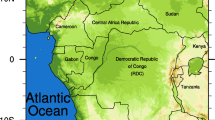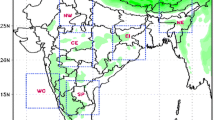Abstract
The monsoon seasons of 2010 and 2011, with almost identical seasonal total rainfall over India from June to September, are associated with slightly different patterns of intraseasonal rainfall fluctuations. Similarly, the year 2012, with relatively less rainfall compared to 2010 and 2011, also witnessed different intraseasonal rainfall fluctuations, leading to drought-like situations over some parts of the country. The present article discusses the forecasting aspect of monsoon activity over India during these 3 years on an extended range time scale (up to 3 weeks) by using the multimodel ensemble (MME), based on operational coupled model outputs from the ECMWF monthly forecasting system and the NCEP’s Climate Forecast System (CFS). The average correlation coefficient (CC) of weekly observed all-India rainfall (AIR) and the corresponding MME forecast AIR is found to be significant, above the 98 % level up to 2 weeks (up to 18 days) with a slight positive CC for the week 3 (days 19–25) forecast. However, like the variation of observed intraseasonal rainfall fluctuations during 2010, 2011 and 2012 monsoon seasons, the MME forecast skills of weekly AIR are also found to be different from one another, with the 2012 monsoon season indicating significant CC (above 99 % level) up to week 2 (12–18 days), and also a comparatively higher CC (0.45) during the week 3 forecast (days 19–25). The average CC between observed and forecasted weekly AIR rainfall over four homogeneous regions of India is found to be the lowest over the southern peninsula of India (SPI), and northeast India (NEI) is found to be significant only for the week 1 (days 5–11) forecast. However, the CC is found to be significant over northwest India (NWI) and central India (CEI), at least above the 90 % level up to 18 days, with NWI having slightly better skill compared to the CEI. For the individual monsoon seasons of 2010, 2011 and 2012, there is some variation in CC and other skill scores over the four homogeneous regions. Thus the slight variations in the characteristics of intraseasonal monsoon rainfall over India is associated with variations in predictive skill of the coupled models and the MME-based predictions of intraseasonal monsoon fluctuations for 2–3 weeks, providing encouraging results. The MME forecast in 2010 is also able to provide useful guidance, well in advance, about an active September associated with a delayed withdrawal of the monsoon and also the heavy rainfall over north Pakistan.












Similar content being viewed by others
References
Brankovic, C., and Palmer, T. N. (1997), Atmospheric seasonal predictability and estimates of ensemble size. Mon. Wea. Rev. 125, 859–874.
Bhalme, H. N. and Parasnis, S. S. (1975), 5–6 days oscillations in the pressure gradients over India during southwest monsoon. Ind. J. Meteor. Geophys., 26, 77–80.
Buizza, R. and Palmer, T. N. (1995), The singular vector structure of the atmospheric global circulation. J. Atmos. Sci., 52, 1434–1456.
Chen, T. C., and Yen, M. C. (1994), Interannual variation of the Indian monsoon simulated by the NCAR Community Climate Model: Effect of the tropical Pacific SST. J. Climate, 8, 1403–1415.
De, U. S., Chatterjee, S. N., and Sinha Roy, K. C. (1988), Low frequency mode in summer monsoon circulation over India. Mausam, 39, 167–178.
Gadgil, Sulochana., Vinayachandran, P. N., and Francis, P. A., (2003), Droughts of the Indian summer monsoon: Role of clouds over the Indian Ocean. Curr. Sci., 85, 1713–1719.
Houze Jr. R. A., K. L. Rasmussen, S. Medina, S. R. Brodzi k, and U. Romatschke, (2011), Anomalous Atmospheric Events Leading to the Summer 2010 Floods in Pakistan. Bull. Am. Meteor. Soc., 92, 291–298.
Kalnay E, et al. (1996), The NCEP/NCAR 40 year re-analysis project. Bulletin of the American Meteorological Society, 77, 437–471.
Klingaman N. P., Woolnough S. J., Weller H, Slingo J. M., (2011), The Impact of Finer-Resolution Air–Sea Coupling on the Intra-seasonal Oscillation of the Indian Monsoon. J Climate, 24, 2451–2468.
Krishnan R., Sundaram S., Swapna P., Vinay, K., Ayantika, D. C., Mujumdar, M. (2010), Crucial role of ocean-atmosphere coupling on the Indian monsoon anomalous response during dipole events. Climate Dynamics. doi:10.1007/s00382-010-0830-2, 1–17.
Krishnamurti, T.N., and Bhalme, H.N., (1976), Oscillations of a Monsoon System. Part I. Observational Aspects. Journal of Atmospheric Sciences, 33, 1937–1954.
Krishnamurti, T. N., and Ardanuy, P., (1980), The 10 to 20-day westward propagating mode and “Breaks in the Monsoons. Tellus 32, 15–26.
Krishnamurti, T. N., and Subrahmanyam, D. (1982), The 30–50-day mode at 850 mb during MONEX. J. Atmos Sci, 39, 2088–2095.
Krishnamurti, T. N., Kishtawal, C. M., Larow, T. E., Bachiochi, D. R., Zhang, Z, Williford, C. E., Gadgil, S., Surendran, S., (1999), Improved weather and seasonal climate forecasts from multimodel superensemble. Science, 285, 1548–1550.
Kulkarni, M. A., Acharya N., Kar S. C., Mohanty, U. C., Tippett M. K., Robertson A. W., Luo J. J., and Yamagata T., (2011), Probabilistic prediction of Indian summer monsoon rainfall using global climate models, Theoretical and Applied Climatology, 91, 441–450.
Madden, R, Julian, P. (1971), Detection of a 40–50 day oscillation in the zonal wind in the tropical Pacific. J. Atmos Sci., 28, 702–708.
Madden, R., Julian, P. (1972), Description of global-scale circulation cells in the tropics with a 40–50 day period. J. Atmos. Sci., 29, 1109–1123.
Madden, R., Julian, P. (1994), Observations of the 40–50 day tropical oscillation: A review. Mon. Wea. Rev. 112, 814–837.
Notaro, M., (2008), Statistical identification of global hot spots in soil moisture feedbacks among IPCC AR4 models. Journal of Geophysical Research, 113, doi:10.1029/2007JD009199.
Palmer, T. N., Brankowic, C., Viterbo, P., Miller, M. J. (1992), Modelling interannual variations of summer monsoons. J Climate, 5, 399–417.
Pattanaik, D. R. (2003), The northward moving low frequency mode: A case study of 2001 monsoon season. MAUSAM, 54, 937–940.
Pattanaik, D. R., (2007), Variability of Convective Activity Over the North Indian Ocean and its Impacts on Monsoon Rainfall Over India. Pure & Appl. Geophysics, 164, 1527–1545.
Pattanaik, D. R., Kumar, Arun, (2010), Prediction of summer monsoon rainfall over India using the NCEP climate forecast system. Climate Dynamics, 34, 557–572.
Pattanaik, Ajit Tyagi and Arun Kumar, (2012) “Dynamical-Empirical forecast for the Indian monsoon rainfall using the NCEP Coupled Modelling System—Application for real time monsoon forecast”, MAUSAM, 63, 433–448.
Pincus Robert, Crispian P. Batstone, Robert J. Patrick Hofmann, Karl E. Taylor and Peter J. Glecker, (2008), Evaluating the present-day simulation of clouds, precipitation, and radiation in climate models. J. Geophys. Res., 113, D14209. doi:10.1029/2007JD009334.
Rajeevan M., Bhate J., Kale J. D., and Lal B., (2006), High resolution daily gridded rainfall data for the Indian region: analysis of break and active monsoon spells. Current Science, 91, 296–306.
Rajeevan, M. and Bhate Jyoti, (2008), A high resolution daily gridded rainfall data set (1971–2005) for meso-scale meteorological studies. NCC Research Report No. 9, India Meteorological Department. (Available from http://www.imdpune.gov.in/ncc_rept/ncc_rept_index.html).
Saha S., Nadiga S., Thiaw C., Wang J., Wang W., Zhang Q., Van den Dool H. M., Pan H. L., Moorthi S., Behringer D., Stokes D., Pena M., Lord S., White G., Ebisuzki W., Peng P., and Xie P., (2006), The NCEP climate forecast system. J Climate, 19, 3483–3517.
Saha Suranjana, Shrinivas Moorthi, Xingren Wu, Jiande Wang, Sudhir Nadiga, Patrick Tripp, David Behringer, Yu-Tai Hou, Hui-ya Chuang, Mark Iredell, Michael Ek, Jesse Meng, Rongqian Yang, Huug van den Dool, Qin Zhang, Wanqiu Wang, and Mingyue Chen, (2012), The NCEP Climate Forecast System Version 2. J. Climate (Under review).
Samala, B. K., Krishnan R. and Roxy, M., (2012), Assessment of one month forecasts of weak Indian monsoons based on the NCEP Climate Forecast System (CFS), Meteorological Applications, 19, 189–199.
Shukla J., Anderson J., Baumhefner D., Brankovic C., Chang Y., Kalnay L., Marx L., Palmer T.N., Paolino D. A., Ploshay J., Schubert S., Straus D. M., Suarez M., and Tribbia J., (2000), Dynamical Seasonal Prediction. Bull Amer Meteor Soc., 81, 2593–2606.
Sikka D. R., and Gadgil S., (1980), On the maximum cloud zone and the ITCZ over Indian longitudes during the southwest monsoon. Mon. Wea. Rev., 108, 1840–1853.
Singh S. V., Kripalani R. H., and Sikka D. R., (1992), Inter-annual variability of the Madden–Julian oscillations in Indian summer monsoon rainfall. J Climate, 5, 973–978.
Soman M. K., and Slingo J., (1997), Sensitivity of Asian summer monsoon to aspects of sea surface temperature anomalies in the tropical Pacific Ocean. Quart J Roy Meteor Soc., 123, 309–336.
Sperber K. R., and Palmer T. N., (1996), Inter-annual tropical rainfall variability in general circulation model simulations associated with the Atmospheric Model Inter-comparison Project. J Climate, 9, 2727–2750.
Suhas E., Neena J. M., and Goswami B. N., (2012), An Indian monsoon intra-seasonal oscillations (MISO) index for real time monitoring and forecast verification. Climate Dynamics. doi:10.1007/s00382-012-1462-5.
Tyagi Ajit, Mazumdar A. B., Pai D. S., (2011), Monsoon 2010 – A Report. IMD Met. Monograph. Synoptic Meteorology No. 10/2011.
Tyagi Ajit, Pai D. S. (2012), Monsoon 2011 – A Report. IMD Met. Monograph. Synoptic Meteorology No. 1/2012.
Vitart Frederic (2004), Monthly Forecasting at ECMWF. Mon Wea Rev., 132, 2761–2779.
Vitart Frederic, Buizza R., Balmaseda M. A., Balsamo G., Bidlot J-R., Bonet A., Fuentes M., Hofstadler A., Moleni F., and Palmer T. N., (2008), The new VAREPS-monthly forecasting system: A first step towards seamless prediction. Q. J. R. Meteorol. Soc., 134, 1789–1799.
Vitart Frederic and Molteni Franco, (2009), Dynamical Extended-Range Prediction of Early Monsoon Rainfall over India. Monthly Weather Review. 137, 1480–1492.
Wang B, Kang I. S., Lee J. Y., (2004), Ensemble simulations of Asian-Australian monsoon variability by 11 AGCMs. J Climate, 17(4), 803–818.
Wang B., Lee J.Y., Kang I.S., Shukla J., Park C. K., Kumar A., Schemn J., Cocke S., Kug J. S, Luo J. J., Zhou T., Wang B., Fu X., Yun W. T., Alves O., Jin E. K., Kinter J., Kirtman B., Krishnamurti T. N., Lau N. C., Lau W., Liu P., Pegion P., Rosati T., Schubert S., Stern W., Suarez M., and Yamagata T., (2008), Advance and prospects of seasonal prediction: assessment of the APCC/CliPAS 14-model ensemble retrospective seasonal prediction (1980–2004). Climate Dynamics (2009) 33, 93–117.
Wang W., Chen M., Kumar A., (2009), Impacts of ocean surface on the northward propagation of the boreal summer intraseasonal oscillation in the NCEP climate forecast system. J Climate, 22, 6561–6576.
Webster P. J., Hoyos C.D., (2004), Prediction of Monsoon Rainfall and River Discharge on 15–30 day Time Scales. Bull. American Met Soc., 85, 1745–1765.
Webster, P. J., Toma V. E., and Kim, H. M., (2011), Were the 2010 Pakistan floods predictable? Geophys. Res. Lett., 38, L04806, doi:10.1029/2010GL046346.
Wheeler, M. and H. Hendon, (2004), An All-Season Real-Time Multivariate MJO Index: Development of an Index for Monitoring and Prediction. Mon. Wea. Rev., 132, 1917–1932.
Wu M. L. C., Schubert S., Kang I. S., Waliser D., (2002), Forced and free intraseasonal variability over the south Asian monsoon region simulated by 10 AGCMs. J Climate, 15(20), 2862–2880.
Yasunari T. (1979), Cloudiness fluctuation associated with the northern hemisphere summer monsoon. J. Met. Soc. Japan, 57, 227–242.
Yasunari T., (1980), A quasi-stationary appearance of the 30–40 day period in the cloudiness fluctuations during the summer monsoon over India. J Met Soc Japan, 58, 225–229.
Acknowledgments
We sincerely acknowledge the ECMWF and NCEP for providing the real time forecast products of their coupled models, which have been used for preparing the multimodel ensemble forecast of Indian monsoon rainfall during the southwest monsoon seasons. The authors are also thankful to the National Climate Centre (NCC) for making available the daily gridded rainfall data used in the present study. The authors are very much thankful to the anonymous reviewers for providing very useful suggestions, which helped a lot in improving the quality of the paper.
Author information
Authors and Affiliations
Corresponding author
Rights and permissions
About this article
Cite this article
Pattanaik, D.R., Rathore, L.S. & Kumar, A. Observed and Forecasted Intraseasonal Activity of Southwest Monsoon Rainfall over India During 2010, 2011 and 2012. Pure Appl. Geophys. 170, 2305–2328 (2013). https://doi.org/10.1007/s00024-013-0670-1
Received:
Revised:
Accepted:
Published:
Issue Date:
DOI: https://doi.org/10.1007/s00024-013-0670-1




